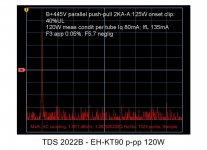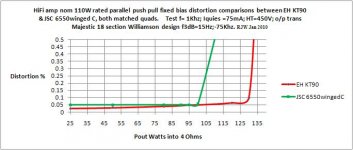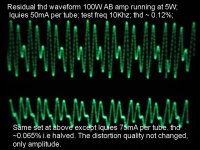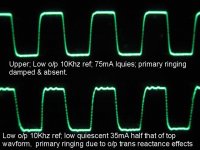The KT90 is a bit of an oddball, originally this tube was designed in the late 1980's in conjunction with David Manley of VTL fame. The first samples I ever saw in fact were VTL branded, laters ones were just plain EI. I ran them at up to 600V in UL with relatively "few" problems.
Note that the KT90 plate structure is borrowed from one of the big EI sweep tubes, they were quite open about this at the time, what else they borrowed I don't know. I do remember the screen grid voltage rating was not far removed from the plate rating.
Edit: I also seem to recall that the curves for this tube were not kinkless under certain conditions - I never encountered a problem with this, but allegedly this is not the most linear output tube in the class.
QC was a bit of a problem right from the get go, the most consistent ones I have ever seen were the ones built early on for VTL, the later ones were considerably less consistent. I did have one (VTL branded) literally explode in my hot rodded Citation II which scared the **** out of me!
I thought good KT90 sounded better in that amplifier than JJ KT88 or even vintage used GEC KT88. I think Trombone here on Diyaudio is still using KT90 in his modified Citation II which is based on my design. You might want to give him a ping for his opinion.
Note that the KT90 plate structure is borrowed from one of the big EI sweep tubes, they were quite open about this at the time, what else they borrowed I don't know. I do remember the screen grid voltage rating was not far removed from the plate rating.
Edit: I also seem to recall that the curves for this tube were not kinkless under certain conditions - I never encountered a problem with this, but allegedly this is not the most linear output tube in the class.
QC was a bit of a problem right from the get go, the most consistent ones I have ever seen were the ones built early on for VTL, the later ones were considerably less consistent. I did have one (VTL branded) literally explode in my hot rodded Citation II which scared the **** out of me!

I thought good KT90 sounded better in that amplifier than JJ KT88 or even vintage used GEC KT88. I think Trombone here on Diyaudio is still using KT90 in his modified Citation II which is based on my design. You might want to give him a ping for his opinion.
I am using the KT90 in a HK Citation with J McShane mods (triode)and have had fine reliability. I hav VTL and EH sets used interchangeability. Also, they are used as push-pull parallel triode into a RAM Labs RM-9 output transformer to attain 70W per amp in mono home built amps. I have experienced no problems with the early VTL labled tubes and the newest EH version sourced from the TUBE AUDIO website as burned in matched quads. Both amp sets run about 450V B+ at 50mills triode and screens connected thru 125 ohm resistors to the plate. These are used in audio reproduction (not specifically guitar amps)
In a few days I'm getting delivery of some EH KT90's to put in my 4x p-pp Slaughter amp: a wind change from 6550 New Ed TungSols. When it comes to THD, I'm finding that Svet 6550C winged C types and these TungSols are also near identical performers in UL with 40% taps with 68R screen res, both versions can take 80mA quies on the plates at 450V without wilting. In comparison the 6550WE clear glass pellet getters is hopeless sod at 30W; that tube behaves more like a rowdy 6L6. The indications for best UL linearity, both tubes like hard screen drive.
Another good tube for low THD is the SED KT88 large S USA Svetlana; I believe nolonger in production, another legal brand confusion as that is also made in Russia only for the US market.
More anon
Richy
I will inform how I get on with EH KT90's.
Another good tube for low THD is the SED KT88 large S USA Svetlana; I believe nolonger in production, another legal brand confusion as that is also made in Russia only for the US market.
More anon
Richy
I will inform how I get on with EH KT90's.
Hello guys and greetings from Serbia!
As I could remember all rumors about Ei KT 90, everything started with Mr Manley, who was in doubt to buy complete 211/VT-4C stock available at that time or to invest in new tube. He decided to start production of new audio output tube ...
...
EI ( Elektronska Industrija) Nis, was only one or maybe one of just a few tube factories in EU at that time, except Soviet Union.
Visually, KT90 by EI look a bit grotesque , because Serbian Glass Factory in Paracin, Serbia, EI supplier of bulbs, wasn’t interested too much to make new shape like KT88. So it looks like EL519, without plate cap and with funny, pretty thin plastic base, vacuum was made at the top of tube, not on the bottom like all real KT tubes were produced for decades.
, because Serbian Glass Factory in Paracin, Serbia, EI supplier of bulbs, wasn’t interested too much to make new shape like KT88. So it looks like EL519, without plate cap and with funny, pretty thin plastic base, vacuum was made at the top of tube, not on the bottom like all real KT tubes were produced for decades.
The guys in EI used EL509/519 structure with slight modifications, but quality of each series differs too much. Some of them are really OK, even more that you could expect of so ugly tube. I had opportunity to match a lot of pairs and quads, there were batches with almost identical parameters, and some of them are still in use after more than 10 years!!!, but at the other side, few late batches were complete disaster, even some of tubes destroyed amplifiers in which they were used.
I still have few quads of different batches, but I need to try to find them (among 20000 tubes ) and to suggest proper batches, if it’s possible to find them nowadays.
) and to suggest proper batches, if it’s possible to find them nowadays.
Good luck with EI KT90, because it’s lottery!!!
As I could remember all rumors about Ei KT 90, everything started with Mr Manley, who was in doubt to buy complete 211/VT-4C stock available at that time or to invest in new tube. He decided to start production of new audio output tube
EI ( Elektronska Industrija) Nis, was only one or maybe one of just a few tube factories in EU at that time, except Soviet Union.
Visually, KT90 by EI look a bit grotesque
The guys in EI used EL509/519 structure with slight modifications, but quality of each series differs too much. Some of them are really OK, even more that you could expect of so ugly tube. I had opportunity to match a lot of pairs and quads, there were batches with almost identical parameters, and some of them are still in use after more than 10 years!!!, but at the other side, few late batches were complete disaster, even some of tubes destroyed amplifiers in which they were used.
I still have few quads of different batches, but I need to try to find them (among 20000 tubes
Good luck with EI KT90, because it’s lottery!!!
Hello guys and greetings from Serbia! ......
I have nothing to add
destiny of EI RC ..... shame .....
anyway - I just wanna say hello to you , and I'm glad that you have now your own site , not hosted on free servers as before .....
feel free to click on forum addy , written in my sig

Visually, KT90 by EI look a bit grotesque, because Serbian Glass Factory in Paracin, Serbia, EI supplier of bulbs, wasn’t interested too much to make new shape like KT88. So it looks like EL519, without plate cap and with funny, pretty thin plastic base, vacuum was made at the top of tube, not on the bottom like all real KT tubes were produced for decades.
The guys in EI used EL509/519 structure with slight modifications, but quality of each series differs too much. Some of them are really OK, even more that you could expect of so ugly tube.
Grotesque? Ugly? I actually rather like the look of them...
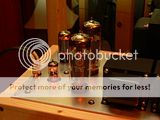
http://i69.photobucket.com/albums/i43/Ty_Bower/Simple SE/P1120152.jpg
I love the way the chassis woodwork complements the architecture in your home.
Thank you. We call that style, "unfinished."
I'm not sure how these relate to the EH KT90s. They are similar in design with a tall, narrow envelope, but they were evacuated from the bottom. The plates are huge and they can take all the current I can throw at them. They sound pretty good in the Simple SE at 100mA...one of my favorites in there.
Yeah, I know but I have a tempting high power switch eg, B+ at 530V and any tube not up to par.......ZAP. I do like to run MI to 175W per ch.
Biassing fine....80mA each quite modest at 265V and 55mA with 88's on high B+. well within specs and no sign of oscillation.
Clearly KT90 Qc looks suspect (yet again in my case) ....considering Manley used them en-masse in their amps. I will have to get mine rechecked and the truth known.
I've always considered KT90's as a "hard tube" electrically, that when driven into clipping as in MI, perhaps there is a more drastic impedance change perhaps a "latch-up" when compared to other tube classes ....OMO. I've never had these problems with the 88 class. ANy o/p tube should survive a slam drive test at full power, i.e square wave into hard clipping them flipped into sine wave without snags. I use a fuse in centre tap o/p tranny and to blow a 1A with quad KT90s is a sure warning signal. The power supply has more poke than a hospital defibrilator.... so respect is needed.
The tubes I find most consistent on power uppage and well tolerant is the JJ KT88's (a pity about the bulb style) ;in comparison theSvetlana KT88 is overpriced and gives lower poke.
richj
kt88's have a maximum rating of 600 volts on the plate. they should run 530 volts just fine. just dont use it at 530 volts all the time.
At last the bench results I was looking for. The setup using a HiFi designed (20dB glob NFB) parallel push pull UL 40% 110W stereo amp using concertina ECF80, Balanced 12BY7 (triode config)Williamson CCS slam Diff driver; original power stage fitted with New Edit TungSol 6550 or JSC Svetlana 6550 winged C types.
Both these last two types give very similiar distortion results. This amp has the privilage of AC driver balance and sep bias adjustments for min thd. Only because of these two is it possible to optimise the performance.This time I raised Iquies for KT90's to 36W per tube. (80mA#450V) this figure is hard for the standard power tubes previously used. In fact the lowest thd was obtained using the 6550WE versions, but these tubes cannot hammer 36W on the anodes. I believe Jim McShane also did research in this.
In all UL circuits, running at a high Iquies does wonders reducing the THD at upper audio frequencies (10Khz) and for the KT90 running at this 80mA Iquies is a breeze. It also is more linear with low valve screen UL grid resistors. One could press Iquies higher into classish A but the returns wasn't worth straining the power supply.
To my suprise I got very similiar thd results but with an extra 10% more throughput power. With a B+ of 450V; one cannot complain.
The remaining details in pic.
The output is remarkably clean; stretching the TDS2022 FFT to show harmonics below 0.05% which was the final figure. Others trying sim; beware, the output tranny used was an excellent balanced item with a b/w up to 75Khz.
I will publish the thd/power results after all is tabulated. Until then,
I take my hat off to New Sensor for getting this EH KT90 tube to perform right. This puts my faith in the EH version; but the Ei KT90's version is noway any match
richy.
Both these last two types give very similiar distortion results. This amp has the privilage of AC driver balance and sep bias adjustments for min thd. Only because of these two is it possible to optimise the performance.This time I raised Iquies for KT90's to 36W per tube. (80mA#450V) this figure is hard for the standard power tubes previously used. In fact the lowest thd was obtained using the 6550WE versions, but these tubes cannot hammer 36W on the anodes. I believe Jim McShane also did research in this.
In all UL circuits, running at a high Iquies does wonders reducing the THD at upper audio frequencies (10Khz) and for the KT90 running at this 80mA Iquies is a breeze. It also is more linear with low valve screen UL grid resistors. One could press Iquies higher into classish A but the returns wasn't worth straining the power supply.
To my suprise I got very similiar thd results but with an extra 10% more throughput power. With a B+ of 450V; one cannot complain.
The remaining details in pic.
The output is remarkably clean; stretching the TDS2022 FFT to show harmonics below 0.05% which was the final figure. Others trying sim; beware, the output tranny used was an excellent balanced item with a b/w up to 75Khz.
I will publish the thd/power results after all is tabulated. Until then,
I take my hat off to New Sensor for getting this EH KT90 tube to perform right. This puts my faith in the EH version; but the Ei KT90's version is noway any match
richy.
Attachments
Okay the graph enclosed is pudding proof that swapping to EH KT90's is a worthwhile bonus. Take note of the operating conditions. Comparing graphical lines, the indications of lower thd at lower powers (as expected) is due to variations in front end and driver stage valves.
Users with other o/p transformers may get slightly different results, but this EH KT90 is worth it's salt, solong the heater current can be supplied.I'm now on listening tests.
From a parallel push-pull advocate,
richy
Users with other o/p transformers may get slightly different results, but this EH KT90 is worth it's salt, solong the heater current can be supplied.I'm now on listening tests.
From a parallel push-pull advocate,
richy
Attachments
Grotesque? Ugly? I actually rather like the look of them...
I spent a lot of time making HF transmitters and AF and HF amplifiers with TV vertical deflection tubes like PL/EL 36/500/504/509/519. 20 years ago those tubes were cheap and so common, you could find them everywhere, every electronic shop, junk yards, in every old TV set thrown away on garbage, flea markets ...
KT90 was intented to be exclusive audio output tube and to be mounted to be visible with plate connection down on socket, but basic EL509 which was never used to be visible looks better than KT90 with that too thin plastic octal base support.
On the contrary, KT tubes were really scarce, like globe shape and ST shape, so maybe it’s grotesque to me just because I was used to that shape too much thanks to benefits of mass production or just because in generaly I simply prefere curves
Richy,
I posted the following:
"This raises the question of how much more anode current do we need (1) beyond that necessary to achieve the desired output level and (2) some slight margin to account for line input voltage fluctuation.
Is there some additional amount that is necessary which reduces distortion or some other parameter that is desirable?"
In Ian's thread about the meng-yue-mini-schematic.
http://www.diyaudio.com/forums/tubes-valves/157134-meng-yue-mini-schematic-18.html
It appears you have answered my question that increasing cathode bias current does reduce THD. Is this a general trend that applies to all output tubes? If so, is there any general guideline to the relationship of % increase in bias to achieve the reduction in THD before the law of diminishing return kicks in.
For example we are working with 6P1P tetrodes. We can get 8W out in PP before clipping if we run 36mA cathode current. Do we need to run 10% more cathode current? 20%?
Is this something that has to be derived imperically for each tube?
Thanks.
Steven
I posted the following:
"This raises the question of how much more anode current do we need (1) beyond that necessary to achieve the desired output level and (2) some slight margin to account for line input voltage fluctuation.
Is there some additional amount that is necessary which reduces distortion or some other parameter that is desirable?"
In Ian's thread about the meng-yue-mini-schematic.
http://www.diyaudio.com/forums/tubes-valves/157134-meng-yue-mini-schematic-18.html
It appears you have answered my question that increasing cathode bias current does reduce THD. Is this a general trend that applies to all output tubes? If so, is there any general guideline to the relationship of % increase in bias to achieve the reduction in THD before the law of diminishing return kicks in.
For example we are working with 6P1P tetrodes. We can get 8W out in PP before clipping if we run 36mA cathode current. Do we need to run 10% more cathode current? 20%?
Is this something that has to be derived imperically for each tube?
Thanks.
Steven
Richy
It appears you have answered my question that increasing cathode bias current does reduce THD. Is this a general trend that applies to all output tubes? If so, is there any general guideline to the relationship of % increase in bias to achieve the reduction in THD before the law of diminishing return kicks in.
derived imperically for each tube?
Thanks.
Steven
The nub in AB is that there is a relationship between choosing a high quiescent current and distortion. Others may have another way of putting this. There is something about this in the Radiotron hd book. (will have to study this)
The 10Khz "full pull o/p" into a dummy load is a nasty test somewhat unrepresentative of true LS load and will stew snubber components, but having chosen a half power level and noted it, measure the thd. Most p-p amps will give rising thd with rising frequency, however increase the quiescent stage current and immediately notice the thd drop. The output tranny is being run harder to overcome the parasitics stray c's/L's which causes complex phase distortions which become ever more lossy with rising frequency and will confuse the phase-picture model that the transformer has, resulting in higher actual current required. The iron hysteresis also throws in thd (mainly 2nd harm) but an E&I core will show less thd than a toroid, because the miniscule airgaps created by the E&I modifys the BH curve, straightening it as permeability is reduced. Not so with a toroid. The quoted HF response of a toroid equivalent may be higher than a good E&I, but in all the toroid circuits I've seen, this addditional performance isn't required. A well designed 18 sectioned E&I should get -3dB 70Khz and can tolerate considerable out of balance DC before performance wilts.
So rising frequency results in higher inefficency. No way round this, the price one pays for a good transformer is meant to reflect the trouble the designer has taken over it. That's why 60u paper is still used as a intersection dilectric medium to cut down on the dielectric losses, which varnish has. So it is a mistake to vacuum impregrate an o/p tranny to the core..
Williamson, Partridge and many other solid names got the winding and math optimisation to a refined process, Sowter too.
The difference between a 3-to 7 section o/p tranny is performance noticeable:14 to 18 section hardly worth the trouble. It's alot easier to make a 14 section.
There is another arguement: There isn't much music content at 10Khz, but neverless there are musical harmonics occasionally present adding to the sound definition, so we open another hot debate of why run quiescent hot ? (transient response is faster and Miller effect is better quenched).
Run at quiescent cool and why not just let thd rip at upper audio frequencies ? The picture is darned awkward. The loudspeaker paints a moving impedance and phase relationship but we need to run over the tricky AB crossover point (seen loading by the o/p tranny changes) that is an area for instability. Correct. If one backs off the quiescent of an AB fixed bias amp
(practically in class C but not quite) so that one knows where the class A ends, there will be ringing in the o/p transformer because it sees the tubes working light exacerbating an undamped zone in the o/p tranny where parasitics rule. Usually the HF ringing is seen. This is why the UL o/p stage is so difficult to properly analyze. The curves may be right etc, but the o/p tranny is the wild boy, always will be one heck of an unpredictable item.
A somewhat thread hijack, but as I see it, so much performance is laid on the output stage; and with whatever o/p tubes used, some accept parasitics better than others and show it with incredibly low thd. It is a case of balancing all those Q's and transformer vectors, and some may be coincidentally nulled. As mentioned in another post, for ultimate HiFi I like those 6550 WE because the thd is so low but the power handling is utterly pathetic. It shouldn't have been named this, but the EH KT90 is now my king as this tube has one heck of a power reserve and it shows all the correct ingredients and the heater sucks.
Happy listening
richy
TheGimp;
Dummy loads tests: By just chance I measured thd vs Iquies set at a low o/p level (5W) i.e 100W stereo AB parallel UL40%; p-p power amp using 2x quad Svet 6550 Winged C in each 1/2; the harmonic details in the pic. The input level remains constant, but as the Iquies moves up the curve, better linearity is obtained then je lower the thd. The same freq v.s thd effect at 1Khz but not anyway so marked.
Notice at low level 10Khz, a 50% Iquies difference of Iquies; thd at is roughly doubled. Every amp will have a different signature depending on boundary conditions, but an increase will be expected in most tube amps.
Bear in mind; the open loop characteristics; this is where no 2 amps are the same. In this instance the global nfb (20dB at 1Khz) gradually runs down to 17dB at 10Khz so THD will increase. The variables are enormous; matched tubes ? open loop gains ? Min thd of test equipment ? The interpretation of all these results is open to variations, but at least the simplest can be examined.
Ideally I would like to spectrum analyse it, but the harmonic levels are low that a filter would have to used to rid the fundamental from input overloading, so instead I used the HP332 analogue monitor o/p.
The conclusion is increasing Iquies reduces upper audio distortion.Study the tube curves that one isn't exceeding dissipation for nothing by running close off the end and again thd will increase. For a tube amp running with a relatively low B+, the advantages are there.
Note: Iquies was measured cathode + screen current.
The next check the same but with a loudspeaker + crossover ?
richy
Dummy loads tests: By just chance I measured thd vs Iquies set at a low o/p level (5W) i.e 100W stereo AB parallel UL40%; p-p power amp using 2x quad Svet 6550 Winged C in each 1/2; the harmonic details in the pic. The input level remains constant, but as the Iquies moves up the curve, better linearity is obtained then je lower the thd. The same freq v.s thd effect at 1Khz but not anyway so marked.
Notice at low level 10Khz, a 50% Iquies difference of Iquies; thd at is roughly doubled. Every amp will have a different signature depending on boundary conditions, but an increase will be expected in most tube amps.
Bear in mind; the open loop characteristics; this is where no 2 amps are the same. In this instance the global nfb (20dB at 1Khz) gradually runs down to 17dB at 10Khz so THD will increase. The variables are enormous; matched tubes ? open loop gains ? Min thd of test equipment ? The interpretation of all these results is open to variations, but at least the simplest can be examined.
Ideally I would like to spectrum analyse it, but the harmonic levels are low that a filter would have to used to rid the fundamental from input overloading, so instead I used the HP332 analogue monitor o/p.
The conclusion is increasing Iquies reduces upper audio distortion.Study the tube curves that one isn't exceeding dissipation for nothing by running close off the end and again thd will increase. For a tube amp running with a relatively low B+, the advantages are there.
Note: Iquies was measured cathode + screen current.
The next check the same but with a loudspeaker + crossover ?
richy
Attachments
Here is another symptom of push pull problems, and quite a regular one. In this example the user turned down the quiescent current with a view for longer tube life creating the lower waveform. The pic shows ringing equating to transformer parasitics having pick & play with poor o/p tube stage damping; hence the ringing. Increase the quiescent and the upper waveform results which is acceptably clean.
Going back to the lower; the ringing can be zobelled' or slewed out with an R/C; the penalty is unnecessary wasted power going into the snubber, and not the intended load. Quite often amp builders come across these problems and bark up the wrong tree in thinking that global feedback is to blame; which it isn't but directly by an underrun output stage. When global nfb is connected as in this case it is, the waveform will appear confusingly in various distorted forms throughout the amp stages. The cue is with a dummy load, ringing of this nature can only occur where an inductor is.
Again a substandard made o/p tranny can show up a raft of defects which requires experience. With high gm tubes, with 40% UL taps a screen to anode zobel is often unavoidable typ 1K+1nF to avoid much higher frequency oscillations, of the leakage inductance and capacitance node.
richy.
Going back to the lower; the ringing can be zobelled' or slewed out with an R/C; the penalty is unnecessary wasted power going into the snubber, and not the intended load. Quite often amp builders come across these problems and bark up the wrong tree in thinking that global feedback is to blame; which it isn't but directly by an underrun output stage. When global nfb is connected as in this case it is, the waveform will appear confusingly in various distorted forms throughout the amp stages. The cue is with a dummy load, ringing of this nature can only occur where an inductor is.
Again a substandard made o/p tranny can show up a raft of defects which requires experience. With high gm tubes, with 40% UL taps a screen to anode zobel is often unavoidable typ 1K+1nF to avoid much higher frequency oscillations, of the leakage inductance and capacitance node.
richy.
Attachments
I have KT 90 wored VTL 225 mono's. Have beenrunning them since the 80'S. Never heard of the KT-90 being able to be used in any circuit other than one designed for it. No interchangeability with anything.
The early / late manufacture date quality information posted here is correct. The late manufactured tubes were the left overs and they SUCK! They can damage the amp and flareup and die.
The early / late manufacture date quality information posted here is correct. The late manufactured tubes were the left overs and they SUCK! They can damage the amp and flareup and die.
- Status
- This old topic is closed. If you want to reopen this topic, contact a moderator using the "Report Post" button.
- Home
- Amplifiers
- Tubes / Valves
- KT90's anyone using'em ?
